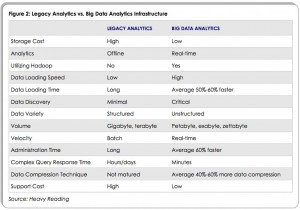
Mobile World Congress is quickly approaching. Attendees and exhibitors are feverishly scheduling meetings, doing research, and determining their areas of focus to maximize their experience of the event. If you're hoping to learn more about big data analytics at the conference, here are some helpful insights and resources to help you prepare.
Big data analytics and Hadoop use cases in the communications and media industries are steadily growing, and include:
- Improving customer experiences.
- Making better pricing decisions.
- Monetizing customer and IoT data.
- Better predicting audience behavior and ratings.
- Planning and optimizing networks more accurately.
A recent report on Using Next Generation Advanced Analytics to Harness Big Data produced by Heavy Reading provides compelling insight on these use cases plus includes market survey data on investment priorities for big data analytics.
Just three years ago, only very advanced technology companies were using Hadoop. Most others were wrestling with legacy analytics systems. And were making decisions based on structured, aggregated data derived from samples. While many of these companies thought they were ahead of the game and probably were at the time, their analytics strategies posed many of the challenges in the above graphic.
Today, the communications and media industries are embracing Hadoop and many companies have either implemented Hadoop or are in the process of implementing, as validated at a SAS hosted communications and media roundtable in October 2014. All of the attendees, represented by many of the leading communications and media companies had Hadoop/big data initiatives being driven by a mix of business and IT.
In a recent interview about Hadoop: The new boardroom buzzword, Adrian Jones, SAS Advisory Business Manager, and Simon Gregory, Hortonworks, EMEA Business Development manager, share useful perspectives on how this big data paradigm shift has occurred and why.
The “how” includes a major shift in the business side of the house seeing data as an asset. This change has sprouted collaboration between the CTO and the IT organization, and between the CMO and Chief Data Officer. Big data initiatives are about data that can change your customers’ perception of your products and services by exposing critical information that you did not have before by analyzing ALL your data vs. a sample.
One of the communications providers SAS is working with analyzed a one-month snapshot of network data to discover that their prepaid customers were having network outages between 9 pm and midnight. Prior to examining this data, they had no idea this was happening. This provider is now implementing a full Hadoop/big data analytics data lake so they can analyze network traffic to continue to uncover similar issues and provide better service to customers. This same company also discovered revenue leakage on the data side during this process and is working to eliminate that as well.
Which brings me to the question, why implement Hadoop? There are many reasons, including: having the ability to integrate this new more agile environment with your legacy systems, being more broad in your analysis – no cubes to build for specific explorations, supplementing your existing systems with new styles of data like unstructured data e.g. social media, and being able to work with new and greater volumes of data.
The global SAS Communications practice will be at Mobile World Congress to discuss many of the big data topics I mention above. We will be located at: SAS Meeting Room - 2D9MR - Hall 2. Please click here to book a seat in one of our presentations.
Please come by and see us! We hope to meet you there!
